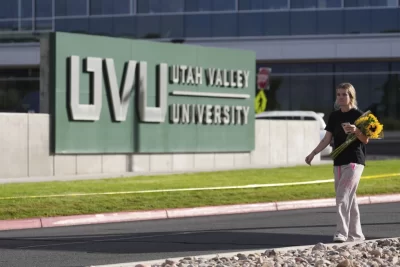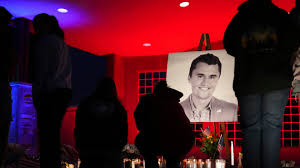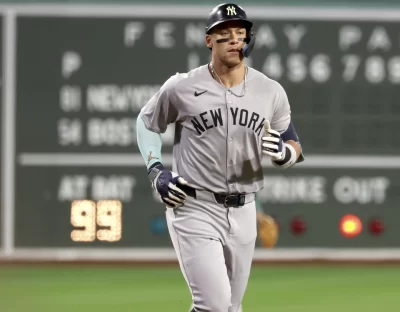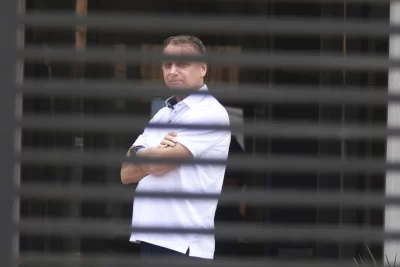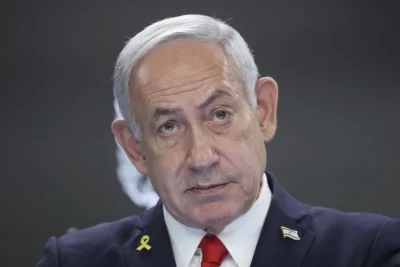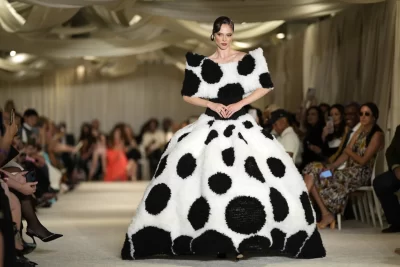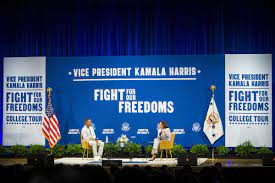
Students were dancing in the aisles and their seats in the Hampton University auditorium long before Vice President Kamala Harris took the stage for the first stop of her fall college tour.
Jaden Clemons and Layth Carpenter, both 18-year-old freshmen, said they viewed Harris as “authentic” and “relatable” as the alum of Howard University, another historically Black school.
But neither was ready to commit to supporting Harris and Joe Biden next year, the first time they will be eligible to vote in a presidential election. And when it comes to lining up behind Democrats or Republicans, Clemons said, “We don’t even feel like it’s something that we need to choose.”
Getting students like these two off the sidelines is one of the top challenges for the White House as Biden seeks a second term as the oldest president in American history, and it’s one that Harris will confront as she crisscrosses between campuses in the coming weeks. Although young people lean left, they’re less likely to vote, and preventing them from tuning out is crucial in close campaigns that hinge on narrow margins.
And Biden isn’t the only candidate trying to line up support among young voters. Former President Donald Trump, the frontrunner for the Republican nomination in his comeback bid for the White House, visited Iowa State University last weekend.
“I guess the youth likes Trump,” he said.
John Brabender, a media consultant for the Trump campaign, said the former president tries to show up at events that lead to video on social media — for example, Trump’s appearance at a mixed martial arts fight in Las Vegas in July.
Since YouTube and TikTok are crucial platforms for young people, he said, “Our goal is to make sure content is created in an interesting enough way that it does get shared.
Drawing the attention of young people can be difficult, but Trump’s celebrity remains powerful. One of the few things that Isaac Gavin, a 21-year-old senior at Drake University in Des Moines, knows about the Republican primary is that Trump is a candidate again.
“I don’t even know all who is running. It seems like so many,” he said. “It’s confusing.”
Sen. Mitt Romney, a Utah Republican who announced his retirement this week, told reporters at the U.S. Capitol that he doubted Trump could make inroads with a new generation.
“My party is only going to be successful getting young people to vote for us if we’re talking about the future,” he said. “And that’s not happening so far.”
Biden won 61% of voters between the ages of 18 and 29 in 2020, according to AP VoteCast, making young voters a critical part of his coalition. However, his approval ratings within that age group now stand at 29% compared to 40% overall, according to a new AP-NORC poll.
At Hampton, Harris said there was too much at stake — abortion, voting rights, gun control — for students to miss their shot to shape the country’s future.
“What concerns me sometimes is that our young leaders will be told that their vote doesn’t matter,” she told the audience. “It’s because you voted,” Harris added, “that Joe Biden is president and I’m vice president of the United States.”
Harris’ college tour — with another stop Friday at North Carolina A&T in Greensboro, N.C. — is one part of a broader strategy.
The White House has worked with online influencers to reach people who don’t rely on traditional media. The Democratic National Committee is also building a network of student volunteers to organize on college campuses, and they flew banners over football games to urge voter registration.
“As Democrats did in 2020 and 2022, we will meet younger Americans where they are and turn their energy into action as part of our winning 2024 coalition,” said Kevin Munoz, a Biden campaign spokesman.
Given the liberal bent of younger voters, Democrats’ competition isn’t always Republicans but apathy or the lure of a third party. John Della Volpe, director of polling at the Harvard Kennedy School Institute of Politics, said the White House will need to break through to people who tend to tune out when it comes to politics so they’re aware of what Biden has accomplished since taking office.
“It’s just an incredibly challenging environment to communicate that message,” said Della Volpe, who worked on Biden’s campaign in 2020. “And unless those things are understood, cynicism grows.”
Destiny Humphreys, a 22-year-old senior at South Carolina State University, said she fears that politicians always say they’ll “listen to the people” only to backtrack once they’re in a position of power.
“Everybody keeps saying the same thing just in different ways but ultimately, they’re not listening to the people,” she said.
On Thursday, Harris repeatedly tried to demonstrate that she understood young voters’ concerns. She said they had taught her about “climate anxiety” and their fears of a warming world.
At another point, she asked how many students had participated in active shooter drills in their schools, and a sea of hands went up. Older people, Harris said, “don’t get it.”
Harris acknowledged that the White House has faced roadblocks, such as the U.S. Supreme Court decision that undermined its debt forgiveness plan. But she said she wouldn’t stop fighting for the administration’s agenda.
“I like to say, I eat ‘no’ for breakfast,” she said. “I don’t hear ‘no.’”
Harris ended with a pitch for help.
“With each generation, we must fight for our rights and our freedoms,” she said. “And so, just stay active. Because I and your country are counting on you.”
After the event, Carpenter said she felt that Harris sort of “danced around” students’ questions and blamed problems on Congress.
But Clemons might have been won over.
Biden and Harris are “strong candidates, in my eyes,” he said, “mainly because of what I saw today.”
___
Price reported from New York and Beaumont from Des Moines, Iowa. Reporting was contributed by Ayanna Alexander in Orangeburg, S.C., and Farnoush Amiri in Washington.

